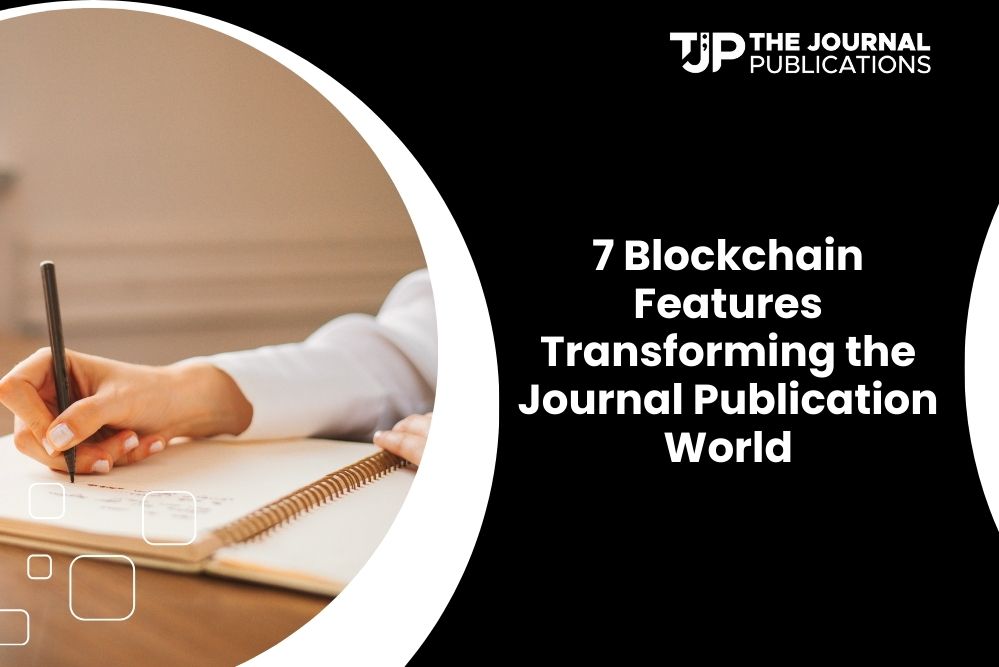Intro
Blockchain technology has revolutionized the journal publications, transforming it beyond recognition in recent years. Blockchain is reshaping research publishing. It addresses key issues: transparency, data integrity, and trust. This tech is revolutionary. It eliminates fraud and boosts collaboration. It sets new benchmarks in online research publishing.
This article will explore seven blockchain features. They are transforming online research paper publishing. We will discuss their benefits for researchers, publishers, and readers.

-
Immutable Records for Enhanced Transparency
A key feature of blockchain is its ability to create immutable records. In the journal publications, this means permanent, tamper-proof records of every step in online research publication.
- How it works: Blockchain timestamps each step, including submissions, reviews, and revisions. This ensures a transparent, verifiable audit trail.
- Impact on trust: This feature proves originality and authorship. It combats issues like plagiarism, duplicate publications, and fraudulent claims. Platforms using blockchain for transparency, like ARTiFACTS and Orvium, are setting new standards.
-
Smart Contracts for Efficient Peer Review
Peer review is key to online research publication. But traditional methods are often slow and inefficient. Blockchain-based smart contracts streamline this process.
- Workflow automation: Smart contracts will assign reviewers, set deadlines, and release payments or rewards once they finish their work.
- Accountability: These contracts record the peer-review process, fostering accountability and reducing bias. Decentralized platforms like Decentralized Science (DeSci) use blockchain to manage peer reviews. This method is open to scrutiny.
-
Decentralization and Accessibility
Traditional publishing often relies on centralized repositories causes is lead to problems restricted access and paywalls. Blockchain’s decentralized architecture offers a solution.
- Open-access journals: Blockchain allows decentralized, open-access platforms. These platforms make research papers free to anyone with an internet connection.
- Global collaboration: Online research paper publications platforms allow researchers worldwide to share and access information.
-
Tokenization for Incentivizing Contributions
Blockchain’s tokenization rewards contributors, including authors, reviewers, and editors. It creates a fair and motivating ecosystem.
- How tokens work: Contributors earn tokens for their efforts. They can exchange them for money, discounts on publication fees, or other benefits.
- Encouraging collaboration: This feature boosts quality work and community participation. It fosters a culture of collaboration and innovation.
-
Provenance and Traceability
Blockchain technology makes it easy to verify the authenticity of research in the digital age by providing a transparent record of a research paper’s entire lifecycle.
- Traceable research outputs: The blockchain records every dataset, experiment, and revision. It provides a transparent lineage of the research process.
- Preventing data manipulation: It stops tampering with results. This ensures that published work is reliable and trustworthy. It boosts the credibility of online research platforms.
-
Enhanced Copyright Protection
Authors often face challenges in protecting their intellectual property. Blockchain addresses this issue by establishing clear and immutable ownership records.
- Timestamped authorship: A blockchain records the time and date of a manuscript’s submission. This is proof of ownership.
- Preventing unauthorized use: This feature keeps authors in control of their work. It deters unauthorized copies and changes.
-
Seamless integration with AI and big data.
Blockchain, combined with AI and Big Data, is revolutionizing online research publications.
- AI can analyze blockchain-stored data. It can find trends, identify potential collaborators, and predict future research directions.
- Blockchain can manage large datasets with security and transparency. It’s best for managing complex research outputs, like multi-disciplinary studies or long-term projects.
Close
Blockchain tech is revolutionizing the journal publication. It boosts transparency, efficiency, and trust. Its features are solving long-standing challenges in the research ecosystem. They range from immutable records to tokenized rewards. As more platforms adopt blockchain, online research paper publishing will improve. It will boost innovation, collaboration, and integrity.
By embracing these advancements, researchers and publishers can unlock new possibilities. This will ensure that knowledge spreads as fast as technology.
FAQs
How does blockchain ensure transparency in journal publications?
Blockchain creates unchangeable, timestamped records of every step in the publication process. This prevents tampering and ensures authenticity.
Can blockchain improve the peer-review process?
Yes, blockchain streamlines peer review. It automates workflows via smart contracts. It records reviews in a clear manner to minimize bias and delays.
Are there any real-world examples of blockchain in online research publications?
Platforms like ARTiFACTS and Orvium use blockchain to improve research publishing. They make it more transparent and efficient.
Is blockchain compatible with open-access models?
It is not possible to remove the adverb. Blockchain supports decentralized, open-access platforms, ensuring global accessibility and eliminating paywalls.
What role does blockchain play in copyright protection?
Blockchain records authorship with timestamps. This proves ownership and prevents unauthorized use of intellectual property.
How does tokenization benefit the research community?
Tokenization rewards contributors for their efforts, incentivizing high-quality work and fostering collaboration.





